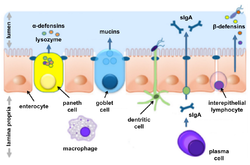
Back ظهارة معوية Arabic Darmschleimhaut German Epitelio intestinal Spanish بافت پوششی روده Persian Épithélium intestinal French Bélhám Hungarian 腸管上皮 Japanese Mucosa intestinal Portuguese
| Intestinal epithelium | |
|---|---|
 Simple columnar epithelial cells | |
 Cell types of the intestinal epithelium | |
| Identifiers | |
| MeSH | D007413 |
| FMA | 15695 17229, 15695 |
| Anatomical terminology | |
| This article is part of a series on |
| Epithelia |
|---|
| Squamous epithelial cell |
| Columnar epithelial cell |
| Cuboidal epithelial cell |
| Specialised epithelia |
|
| Other |
 |
| This article is one of a series on the |
| Gastrointestinal wall |
|---|
The intestinal epithelium is the single cell layer that forms the luminal surface (lining) of both the small and large intestine (colon) of the gastrointestinal tract. Composed of simple columnar epithelium its main functions are absorption, and secretion. Useful substances are absorbed into the body, and the entry of harmful substances is restricted. Secretions include mucins, and peptides.
Absorptive cells in the small intestine are known as enterocytes, and in the colon they are known as colonocytes. The other cell types are the secretory cells – goblet cells, Paneth cells, enteroendocrine cells, and Tuft cells. Paneth cells are absent in the colon.[1][2]
As part of its protective role, the intestinal epithelium forms an important component of the intestinal mucosal barrier. Certain diseases and conditions are caused by functional defects in the intestinal epithelium. On the other hand, various diseases and conditions can lead to its dysfunction which, in turn, can lead to further complications.
- ^ Noah, TK; Donahue, B; Shroyer, NF (15 November 2011). "Intestinal development and differentiation". Experimental Cell Research. 317 (19): 2702–10. doi:10.1016/j.yexcr.2011.09.006. PMC 3210330. PMID 21978911.
- ^ Litvak, Y; Byndloss, MX; Bäumler, AJ (30 November 2018). "Colonocyte metabolism shapes the gut microbiota". Science. 362 (6418). Bibcode:2018Sci...362.9076L. doi:10.1126/science.aat9076. PMC 6296223. PMID 30498100.